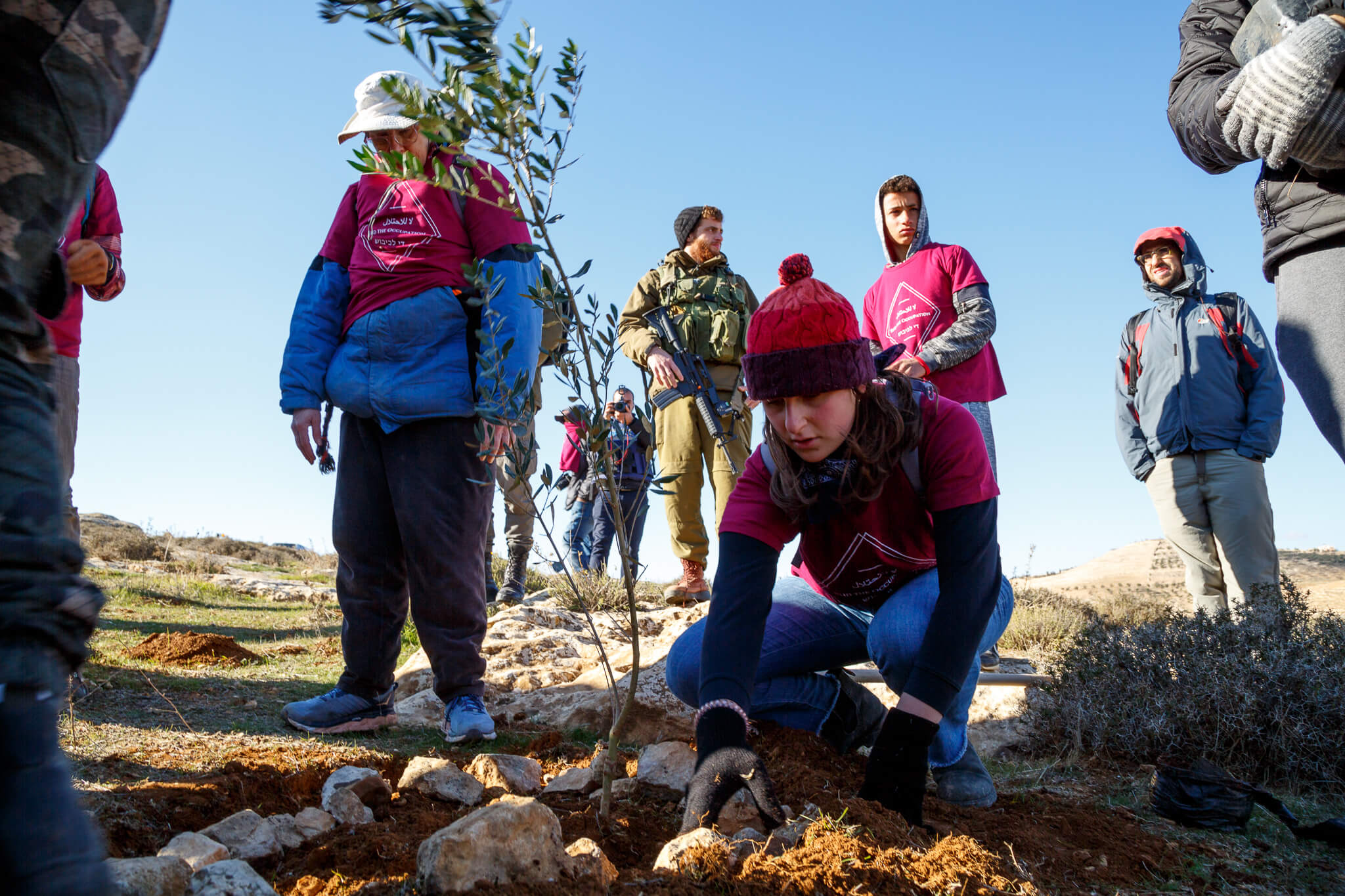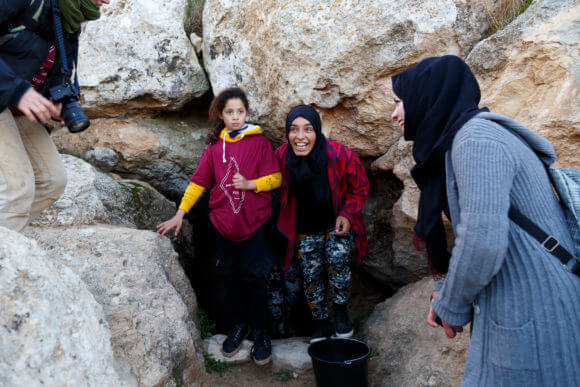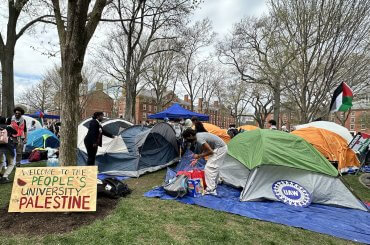At daybreak Kefah Adra set out to fill a plastic container of water from a nearby spring, a morning errand she has not done in 15 years. Adra lives in a-Tuwani, a bucolic herding community set on a landscape of wide hills and boulders on the outskirts of Yatta in the South Hebron Hills. Adra is lucky, in 2010 a-Tuwani was connected to municipal power and water, unlike the ramshackle tents, caves and stone homes powered by diesel generators in the surrounding villages. However, like many Palestinian towns in this southern region of the West Bank, a-Tuwani is hemmed in by Israeli settlements, which a decade and a half ago cut off access to her water source.
“Once Israeli settlers began swimming in this spring, it was no longer safe for us to drink,” Adra explained. “For many years, we could not access the spring at all.”
In 2001 the outpost of Avigayil was built, a small community of around 50 Israelis who constructed their village without approval from the Israeli government. The outpost was slated for demolition several times, but the order was never enforced. In 2004, the outpost expanded to the spring.
Friday morning, Adra and around 100 others, a combination of Palestinian families and Israeli and international volunteers, paraded one mile to the spring. The Palestinians brought donkeys loaded with yellow canisters ready to collect water.
“We would travel 1.5 kilometers on our donkeys, just like we did today,” Adra told a group of volunteers. “I am so happy to be back at this spring… I hope that through the work we started today, the people of this region can use this water again.”
Some began repairs to the area, clearing overgrown vegetation and removing obstructive rocks around the spring to improve access. Others planted olive trees, explaining it was an effort to reclaim the spring.
Activists affixed a sticker to a road sign pointing to the spring labeled in Hebrew “Avigayil Spring” to its Arabic, Ein al-Beida.
Within minutes of the sign going up, Israeli settlers driving by pulled over, ripping it down along with Palestinian flag which was also raised. One settler screamed out the window, “all dogs die like this,” and made a throat-slashing gesture. Around 20 Israeli soldiers arrived.

Palestinians and activists gather by Ein al-Beida in the South Hebron Hills, accessing the natural spring for a first time in a decade and a half after it was confiscated by a nearby Israeli outpost. (Photo: Miriam Deprez)

Ein al-Beida is one of just 60 springs in the area that have been taken over or are at risk of takeover by either Israelis or Israeli authorities in recent decades. In the West Bank, access to natural sources of water, either springs or wells are scarce. In 1967 when Israel took control of the West Bank, a moratorium was placed on digging new wells. This was reinforced in 1995 by the Paris Protocols of the Oslo Accords, which delineated a water-sharing agreement and capped how much water Palestinians and Israelis could pump from three main aquifers in the region. Although the population of the West Bank has doubled since the agreement was signed, the water allocation has remained the same.
For Israel’s portion, 80 percent of the recharge comes from rainwater that falls over the West Bank.
Israel laid water infrastructure throughout the South Hebron Hills, which pumps piped water directly into sinks inside of settlements. Surrounding Palestinian villages were never hooked into the water infrastructure, and connections to Palestinian Authority water pipes are banned.
The South Hebron Hills falls in Area C of the West Bank, under full Israeli military and civilian administration. This means for towns like a-Tuwani, water infrastructure projects like any other building project must obtain a permit from the Israeli Civil Administration or face demolition. Between 2010 and 2014, the civil administration rejected 98.5 percent of all Palestinian building permit applications for Area C projects across the West Bank. For many Palestinian communities, their only option for water is to build rain cisterns or resort to purchasing expensive tanker water.
Some communities do build unlicensed water lines, of which dozens were demolished or confiscated in 2019 alone. In February, Israeli authorities confiscated two donor-funded water pipes affecting around 1,300 people in 12 communities in the Massafer Yatta, or “Greater Yatta,” area in South Hebron.


“People in the south [Hebron Hills], they’re not getting enough water,” Awdah Hathaleen said, a 24-year-old activist with the Good Shepherd Collective from nearby village Umm al-Khair. “The World Health Organization says that the [minimum is] 100 liters per person, but sometimes they get less than 20 liters per day for each person.”
According to the United Nations, around 270,000 Palestinians in Area C are directly affected by Israeli restrictions and control of water and sanitation networks, with around 95,000 people receiving less than 50 liters of water per capita per day, while over 83,000 people receive poor quality drinking water. By contrast, settlers use up to around 300 liters per day or six times the amount of water compared to neighboring villages in the West Bank.
“The people are suffering,” Hathaleen continued. “We are not allowed to dig a well or make water cistern. The settlements here have water 24 hours. But the [Palestinian] people here, they’re suffering from the lack and shortage of water. I hope our resistance today and our work, the people will start to reuse this water spring.”
“I think it went well, nobody got arrested,” Kefah’s 23-year-old son and activist, Basil Adra, told Mondoweiss as the group walked back to his village at the end of the action.
“There was some harassment from the army, from the border police. But the main harassment was from the settlers as you saw,” Adra explained. A day after planting olive trees, settlers had ripped them out of the ground.
And because of this overt aggression, Adra lamented, Palestinians will still need to be accompanied by activists if they want to use the spring again.
“For me, it’s a good beginning for the people to go back and to be brave to use their land. But for sure they will always want someone to protect them or to be with them because it’s very close to the road to Avigayil.”
“With the Jewish people with us [the soldiers] will behave, they will not treat [the Jewish activists] the same way as they treat us. If we are alone we cannot do this.”
“It’s good to have solidarity,” Adra said smiling.


